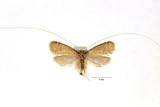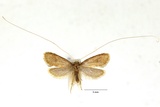Nematopogon metaxella (Hübner, 1813) Species
Last modified: Feb. 20, 2024, 3:58 p.m.
A rare species in Belgium, more observed in the northern part of the country.
Details
- Classification
- Family: Adelidae > Subfamily: Nematopogoninae > Genus: Nematopogon > Species: Nematopogon metaxella
- Vernacular names
- Brede langsprietmot (NL), Buff Long-horn (EN), Auwald-Langhornfalter (DE)
- First mention in Belgium
- De Fré Ch. 1858. Catalogue des Microlépidoptères de la Belgique. — Annales de la Société entomologique belge 2: 45–162. On page 115 (as N.[ematopogon] Metaxella. H.). view page
- Status
-
Native
Distribution
Imago
Wingspan 13–16 mm in male, female slightly smaller 11–14 mm. Antennae whitish. Forewing comparatively broad, pale yellow ochreous with weak reticulation and a blurry spot at the end of the cell. Male in contrast to all other Nematopogon species with a row of broader scales in the outer part of the hindwing.
Caterpillar
Greyish-white, with a brownish tinge. Head dark brown, almost black; prothoracic plate dark brown; meso- and metathoracic plates lighter brown.
Case
9–10 mm, flat, constructed with 4 to 6 crescent-like leaf particles.
Bionomics
The larva lives in a small case of silk mixed with other debris, later becoming a flat oblong one. The larvae hibernate in the case on the ground, where pupation takes place. The larval stage can take two years; in that case, the caterpillar pupates just before hibernation.
The adult moths are active during the day. Males have been observed swarming just before sunset. They occasionally come to light. Females always hide in the lower vegetation, but sometimes may be observed on light.
Flight periods
The adults fly in one generation a year from late May till July.
Observed on
- Substrates:
- Dead leaves
The caterpillar feeds on fallen leaves of a variety of herbaceous plants, like Vaccinium, Betula as well as on detritus.
Habitat
Moist forests with an undergrowth of herbaceous plants, like Vaccinium, Calluna, Carex, Rubus.




